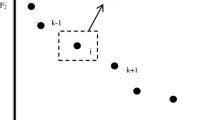Abstract
Economic profit of machining is essentially based on the optimal selection of cutting parameters. In this paper, a multi-objective particle swarm optimization approach is introduced to optimize the cutting parameters in turning processes: cutting speed, feed rate and cutting depth. The proposed model presents the problem in form of a multi-objective problem with production rate and used tool life objectives and has a set of constraints that represent the important limitations to be satisfied. To obtain the non dominated solutions and build the Pareto front graph, a modified dynamic neighborhood particle swarm optimization (DNPSO) technique is used. In addition, a fuzzy-based mechanism is employed to extract the best compromise solution. The results on an illustrative sample reveal the capabilities of the proposed DNPSO approach to generate well-distributed Pareto optimal solutions. Comparison with multi-objective deterministic approach (Min–Max) shows the superiority of the proposed approach and confirms its potential for solving multi-objective problems.


Similar content being viewed by others
Abbreviations
- a :
-
Depth of cut (mm)
- c 1, c 2 :
-
Acceleration constants
- C 0 :
-
Machining cost ($/min)
- C 1 :
-
Cost of tool edge ($)
- Cl :
-
Labour and overhead cost($)
- Ct :
-
Tool cost ($)
- E i :
-
Pseudo-cost
- f :
-
Feed rate (mm/rev)
- f i :
-
Objective functions
- F c , F max :
-
Cutting force and maximum allowed force (N)
- g i :
-
Inequality constraints
- k T :
-
Constant of tool life expression
- K :
-
Penalty parameter
- m :
-
Swarm size
- M :
-
Metal removal rate (mm3/min)
- n :
-
Neighborhood size
- Nite :
-
Maximum number of iterations
- N obj :
-
Number of the objective functions
- N sol :
-
Number of non dominated solutions
- P, P max :
-
Power required for machining, maximum allowed power (kW)
- Pr :
-
Production rate (min)
- Pc :
-
Production cost ($)
- r 1, r 2 :
-
Random constants
- R, R max :
-
Surface roughness and maximum allowed roughness (μm)
- T :
-
Tool life (min)
- T s , T c , T i :
-
Tool set-up time, tool change time, the time during which tool does not cut (min)
- u i :
-
Membership function
- Ut :
-
Used tool life (%)
- v :
-
Cutting speed (mm/min)
- V :
-
Removed metal (mm3)
- V i :
-
Particle’s velocities
- w :
-
Inertia weight
- X i :
-
Particle’s position
- α 1, α 2, α 3 :
-
Exponents for tool life expression
- φ :
-
Penalty function
References
Agapiou JS (1992) The optimization of machining operations based on a combined criterion. Part I: the use of combined objectives in single-pass operations. J Eng Ind 114:500–507
Sonmez AI, Baykasoglu A, Filiz IH (1999) Dynamic optimization of multipass milling operations via geometric programming. Int J Mach Tools Manuf 39:297–320
Wang J, Kuriyagawa T, Wei XP, Guo DM (2002) Optimization of cutting conditions for single pass turning operations using a deterministic approach. Int J Mach Tools Manuf 42:1023–1033
Lee BY, Tarng YS (2000) Cutting parameter selection for maximizing production rate or minimizing production cost in multistage turning operations. J Mater Process Technol 105:61–66
Zuperl U, Cus F (2003) Optimization of cutting conditions during cutting by using neural networks. Robotics Comput Integr Manuf 19:189–199
Cus F, Balic J, Zuperl U (2009) Hybrid ANFIS-ants system based optimization of turning parameters. J Achiev Mater Manuf Eng 36:79–86
Sardinas RQ, Santana MR, Brindis EA (2006) Genetic algorithm-based multi-objective optimization of cutting parameters in turning processes. Eng Appl Artif Intell 19:127–133
Ray T, Lew KM (2002) A swarm metaphor for multi-objective design optimization. Eng Optim 34:141–153
Fieldsend JE, Singh S (2002) A multi-objective algorithm based upon particle swarm optimization, an efficient data structure and turbulence. In: Proceedings of the 2002 U.K. workshop on computational intelligence, Birmingham, UK, pp 37–44
Deb K, Goel T (2001) A hybrid multi-objective evolutionary approach to engineering shape design. In: Proceedings of first international conference, EMO 2001 Zurich, Springer, Switzerland, pp 385–399
Ourique CO, Biscaia EC, Pinto JC (2002) The use of particle swarm optimization for dynamical analysis in chemical processes. Comput Chem Eng 26:1783–1793
Shen Q, Jiang JH, Jiao CX, Shen G, Yu RQ (2004) Modified particle swarm optimization algorithm for variable selection in MLR and PLS modelling: QSAR studies of antagonism of angiotensin II antagonists. Eur J Pharm Sci 22:145–152
Ghoshal SP (2004) Optimization of PID gains by particle swarm optimization in fuzzy based automatic control. Electr Power Syst Res 72:203–212
Tandon V, El-Mounayri H, Kishawy H (2002) NC end milling using evolutionary computation. Int J Mach Tools Manuf 42:595–605
Yu X, Xiong XY, Wu YW (2004) A PSO-based approach to optimal capacitor placement with harmonic distortion consideration. Electr Power Syst Res 71:27–33
Coello Coello CA, Lchuga MS (2002) MOPSO: a proposal for multiple objective particle swarm optimization. In: Proceedings of the IEEE congress on evolutionary computation (CEC 2002), Honolulu, Hawaii, USA, pp 1051–1056
Parsopoulos KE, Vrahatis MN (2002) Particle swarm optimization method in multi-objective problems. In: Proceedings of the ACM symposium on applied computing (SAC 2002), Madrid, Spain, pp 603–607
Hu X, Eberhart RC (2002) Multi-objective optimization using dynamic neighbourhood particle swarm optimization. In: Proceedings of the IEEE congress on evolutionary computation (CEC 2002), Honolulu, Hawaii, USA, pp 1677–1681
Shabiul I Md, Nowshad A, Mukter Z, Bhuyan MS (2008) Fuzzy based PID controller using VHDL for transportation application. Int J Math Model Methods Appl Sci 2:143–147
Author information
Authors and Affiliations
Corresponding author
Rights and permissions
About this article
Cite this article
Ameur, T., Assas, M. Modified PSO algorithm for multi-objective optimization of the cutting parameters. Prod. Eng. Res. Devel. 6, 569–576 (2012). https://doi.org/10.1007/s11740-012-0408-4
Received:
Accepted:
Published:
Issue Date:
DOI: https://doi.org/10.1007/s11740-012-0408-4




